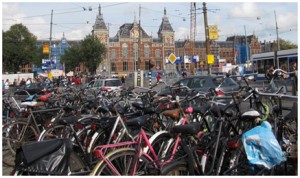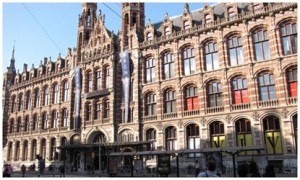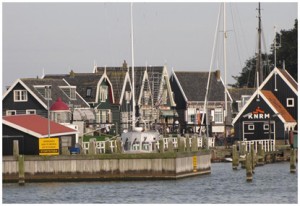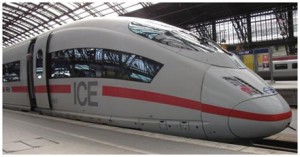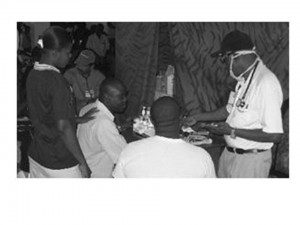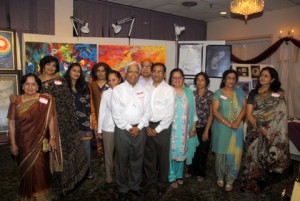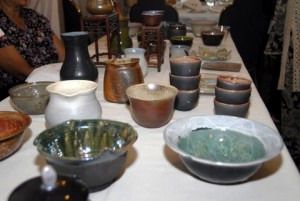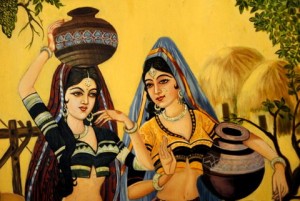Personally speaking: My love affair with Pittsburgh
Posted by admin in January 2011 on December 24, 2010
By Kamana Mathur e-mail: kamana@mathurlaw.us
 Kamana Mathur, an immigration attorney, was born in Lucknow, and was schooled in the US. She returned to India with her parents and graduated from Lady Sri Ram College, New Delhi. Returning to the US, she earned her law degree from the George Washington University School of Law, while working full-time and raising her son. She worked in the US State Department in New Delhi as a Foreign Service Officer and Consular Officer. She is proud that her son Anuraag completed his tour of duty in Iraq as a US Marine.
Kamana Mathur, an immigration attorney, was born in Lucknow, and was schooled in the US. She returned to India with her parents and graduated from Lady Sri Ram College, New Delhi. Returning to the US, she earned her law degree from the George Washington University School of Law, while working full-time and raising her son. She worked in the US State Department in New Delhi as a Foreign Service Officer and Consular Officer. She is proud that her son Anuraag completed his tour of duty in Iraq as a US Marine.
I would often stand in front of the picture my father had taken many years ago, when I was a little girl in India. It was taken in front of an interesting building, ornate but quite different from the buildings I was used to. Little did I realize then that one day, I would be standing in front of the same building – the Cathedral of Learning in Pittsburgh. After I moved to Pittsburgh, one of my first outings was to visit the imposing building and the nationality rooms in it. I was impressed.
Several weeks ago, as part of my job as an attorney, I drove from Pittsburgh to Washington, D.C. at 3:30 am for a 9:30 am court hearing.  As I was lamenting that I had to do so at this early hour, I came out of the Fort Pitt tunnel. And I was mesmerized yet again as the strikingly beautiful Pittsburgh skyline simply exploded in front of my eyes. Quiet but still stunning at this early hour.
The 5-hour drive on the nearly deserted roads was a good time for reflection. While the dazzling views first attracted me to the city, my love affair with Pittsburgh evolved slowly, hesitatingly, with the ups and downs that are part of every true romance.  The historic districts, ethnic cuisine, and lively music scene slowly grew on me. It was a life dramatically different from anything I had experienced.
I was undoubtedly an outsider. But then, having grown up being the “new girl†in school as my family moved nearly every year cross-country and around the world, I developed an outgoing personality that served me well. As I got to know the “locals,†the differences no longer mattered — all I could see were the similarities with practically every other community I’ve experienced worldwide.
Pittsburghers are hard-working and generous individuals. They are also fiercely independent and opinionated (not unlike me). None of the pretense and self-absorption so prevalent in more “fast-paced†cities.  What surprised me, however, was the fact that despite the excellent colleges and hospitals, the stunning scenery, and the great cuisine, only three percent of Pittsburgh’s population is foreign-born. We are unable to attract and retain top international talent.
Could it be that Pittsburghers don’t welcome the “foreign born?â€Â Could it be that there aren’t enough organizations helping to integrate the international community into the fabric of society? It seems to me there are a lot of groups seeking to do just that.
Perhaps people just don’t know about Pittsburgh. Several international journalists and world leaders admitted to not knowing much about the city prior to the G-20. I believe them. Prior to becoming engaged to a native Pittsburgher, I had never visited the city and had always considered it a gritty steel town – not a tourist destination. Soon after I moved here, though, the city won the coveted “Most Livable City†award. Also cited as one of the best places in the world to retire, home to some of the nation’s finest educational institutions, and an architectural marvel, I quickly learned it was more than just a beautiful face.
As I explored the city, I visited the ethnic neighborhoods, each with a unique personality. I watched as the shadows of the late afternoon sun shimmered and danced on the glass of PPG place, making me feel like Alice in Wonderland. Encouraged by cheering crowds, I participated in the Pittsburgh Half-Marathon.
I biked the paths along the city’s rivers.  I kayaked area lakes and hiked the local trails. I became involved in community events and got to know Pittsburgh’s residents. And of course, I attended a ball game.
The city has soul. I’m so happy to call it home.   ♦
The Challenge of the Belly — Paet ka Savaal
Posted by admin in January 2011 on December 24, 2010
By K. S. Venkataraman
e-mail:Â Â ThePatrika@aol.com
In the literary traditions in Indian languages, poets have been borrowing ideas, imageries, similes and metaphors back and forth from other languages through the millennia. One common theme in Indian poetry is poets addressing their own minds, eyes and ears.
One that many Karnatic music lovers know is a composition in Telugu, Sadhinchanay, O, Manasa by Tyagaraja (18th century). In this, the lyricist addresses his own mind: “What have you accomplished, Oh, mind?â€Â telling himself not to be carried away by his own accomplishments.â€Â Even though Tyagaraja seems to be talking to himself, his real audience are his listeners. This is an effective technique for conveying important messages. When you hum the song, unknowingly you are addressing your own vanity. So, at least for a short time, your vanity and pride are contained.
As a technique in poetry, this is very old in the Indian tradition. There are poems, I am sure, in every Indian language along similar lines.
A similar 4-line verse is by the grandmotherly Tamil poet  Ouvaiyaar, one of the greatest Indian poets. Her time is not known, but is believed to be over a millennium. Even as late as several decades ago, when they taught Tamil alphabets to children, they used Ouvaiyyar’s works in which she weaves ethical codes of conduct, secular even by today’s standards, starting with Tamil alphabets, a, aa, i, ii, u, uu, etc. Compared to Ouvaiyyaar’s enlightened sophistication, the English equivalent of A for Apple, B for Boy… is banal. In Ouvaiyyar’s 4-line verse the opening two lines run thus in translation:
If I implore, “Forgo meal for a day,†you refuse;
If I tell you, “Eat food for two days together,†you refuse.
You may think she is addressing her servants, her child, or somebody else. But the Grand Old Lady is addressing her own stomach as if her stomach is capable of listening to her. The last two lines in translation:
You never ever recognize my difficulty, Oh, my stubborn belly!
Living with you is, indeed, very difficult.
That is perhaps what they mean in the colloquial Hindi idiom, paet ka saval, or “the challenge of the belly.â€
Here are all the four lines of the Grand Old Lady’s rhyming verse for those who can read Tamil:
A Helping Hand
Posted by admin in January 2011 on December 24, 2010
By Mani Manoharan, Upper St. Clair, PA
email: mani_tnf@yahoo.com
Sri Venkateswara Temple, along with several other temples in the United States, dedicated the weekend of October 2nd for honoring Gandhi Jayanthi as “Hindu Seva Divas†by offering service for the local communities. This was an initiative of Hindu Mandir Executives Conference. In its first ever service activity organized with coordinators from several temples across USA, twenty temples participated this year and is expected to improve in the coming years.
On October 2nd and 3rd, volunteers from SV Temple and Hindu-Jain Temple had the privilege to volunteer at the “Jubilee Soup Kitchen†located on Wyandotte Street, off Fifth Avenue, near downtown Pittsburgh. Scrumptious vegetarian food prepared by the volunteers and temple cooks were served for 120 people each day.
The guests were primarily older men, and a few women, and one young mother with two children. All of them were very appreciative for the food and came back for seconds. Some even took food out for a later meal.
The kitchen operates under a very tight budget. Almost everyone who works there is a volunteer, and the kitchen is completely supported by private donations.
The kitchen welcomes those whose lives are challenged by poverty, illness, joblessness, or homelessness. The kitchen serves hot noon meals 365 days a year.
Sri Venkateswara Temple is planning to increase this service to once in three months or more. Seva Divas provided an opportunity for many physicians to volunteer at a community health fair in Monroeville Municipality, educate senior citizens in Concordia Center in Cabot, PA on October 7.
SV Temple also donated money to Greater Pittsburgh Community food to purchase 1500 food cans for distribution to those in need. Youth from Hindu Jain Temple helped clean up the Illini Drive surroundings.
The model of Hindu temples serving the community on a coordinated basis on the same across USA is new and Pittsburgh had the unique opportunity to lead such an effort. It provided an opportunity to understand the needs of the community so that Hindus in US can contribute to the benefit of the main stream society.
For more information on the Soup Kitchen, please visit www.jubileesoupkitchen.org.    ♦
Virtual Reality
Posted by admin in January 2011 on December 24, 2010
Asmita Ranganathan
e-mail: drsranga@yahoo.com
No time to talk to his father or mother —
Maybe a sister and maybe a brother;
He rejects them all and gladly embraces
A hundred and ten eager virtual faces.
He logs on to Facebook and reads all the posts;
Here one friend complains, there another one boasts;
He sends texts to a few, they text him replies,
Then back to the screen — How the evening flies!
Family members separated by walls,
Conversation interrupted by images and calls.
No time to talk to those really near,
Companionship — so-called — of those virtually here.
Isolation of people, friendship with machines
Virtual windows showing virtual scenes.
Each keeps to himself, yet his thoughts are laid bare
To forty different people, but how many care?
Oh! How quickly by machines man is seduced,
Conversation is lost, autism is induced;
What a killjoy I am, a spoilsport, a pain!
I had vowed to be quiet, but I’ve done it again!                ♦
Living with Nature Without Overpowering It
Posted by admin in January 2011 on December 24, 2010
Premlata Venkataraman
e-mail:Â ThePatrika@aol.com
Holland is a good example of humans adapting to the environmental constraints imposed by Nature, instead of designing a lifestyle by overpowering it with all bad consequences. About 30% of the land mass is below sea level, and 10% of its land along the coast is reclaimed from the North Sea. Historically, the country was prone to perennial flooding, making farming a perilous activity. However, by digging canals — some of them only a few feet wide and interconnecting them to larger ones — and building dykes, they pump the water back into the sea. Amsterdam, situated only two meters above sea level, is as flat as a pancake, a city that beautifully interweaves water and land.
The canals, used primarily to divert water from land into the sea, also provide an efficient and scenic way to traverse the city. Gliding along the waters, one can see many 17th century buildings – some magnificent, and many cute — still pristine in condition. Ongoing restoration projects, many of them publicly funded, preserve the old buildings like new.
A popular mode of transportation around Amsterdam seems to be the bicycle. Outside the Centraal train station there are hundreds upon hundreds of bikes chained to posts in marked parking areas, or in a three-story bikes-only parking garage. Roads have well marked bike lanes and bicyclists abide by signal lights for their lanes.
The unique architecture of the buildings also sported some unique designs. Grand entrances through massive doors lead into the house. Meanwhile small doors just below the floor level were, in olden times, for use by the servants. Also, historically the tax for the house was calculated according to the width of the house on the street. Consequently, there were some ridiculously narrow houses stuck in between bigger ones, with narrow, steep stairs. So, all buildings have hooks on the top on the outside to haul household goods to upper floors.
This was apparent on a visit to Anne Frank’s house, one of Amsterdam’s famous residents. Her account of the Holocaust, chronicled in her diary makes vivid the agony suffered by millions of Jews. Her family lived hidden in one of the attics behind a bookcase. In a guided tour, climbing through those steep narrow stairs up to an airless attic brought alive to the visitor to glimpse her suffering.
Driving away from the city gave way to scenic farms with dairy cows and sheep grazing — cheese making is big business here. The ancient fishing village of Volandam provided a snapshot of life here centuries ago. Men dressed in loose black trousers with bowties and women in long dresses with intricately laced aprons strolled along the streets. Their homes clustered within narrow pathways and narrow canals to drain the water, and walking through them you experienced the close-knit community. Many homes used to be on stilts to avoid flooding. Since the canals and dykes have eliminated this problem, owners have built walls around the stilts, adding more living space.
Next, we took a train to Rotterdam. Railway stations and riding trains are pure nostalgia to us who used to take long train journeys to reach our ancestral villages in India. Even entering the cavernous station evokes pleasant memories. Everything from purchasing our tickets to getting to the platform was easy and efficient. Platforms were spotless and signage made maneuvering easy, as in airports. Inside our rail car, monitors kept us informed how fast the train was moving and when the next station was scheduled to arrive. Sitting on comfortable seats with spacious luggage racks made for a very pleasant journey.
Rotterdam, one of the largest seaports in the world, is a huge fully automated shipping center, transporting goods from many parts of the world to Northern Europe. Even the Rotterdam railway station was huge and intimidating. Our destination was Brielle, pronounced Brie-luh as our Afghani taxi driver informed us. The main roadway had exits for harbor numbers through 9999!!! We also passed through a huge Shell refinery where crude oil from the Middle East and North Sea is processed and stored in huge containers. These containers stretched for a few mile on the roadway. We also saw dedicated trains carting cars from Korea and Japan to temporarily place them in large garages.
After an hour we were in the small town of Brielle. A very small city with a prominent historic past, it had a little something for all visitors. A huge cathedral over powered the city, beautiful canals, old-fashioned windmills, small winding streets paved with cobblestones and several boutique restaurants. By sunset the streets were empty and kids plied their bikes on the Main Street!
The Brielle Cathedral, an imposing structure established in 13th century, was in excellent condition. The cathedral had beautiful stained glass windows and the pews were old polished hardwood. Many famous people were entombed there and there was a commemoration of the wedding of William of Orange to Charlotte Bourbon. The walks along the canal were endless and benches placed along them to rest and admire the picture perfect scenery.
Near Brielle we drove through an area currently being reclaimed from the sea. The work has been going on for the last several years. It was surreal to stand on new reclaimed ground and watch massive pipes bringing in a slurry of sand and gravel from the ocean floor far away and pumping it onto the land to make new land available.
Historically, though Holland was a small country, its ships ruled the waters, and they are the first one to harness wind energy on a large scale. In modern times, Holland with large area at or below sea level, uses technology to manage water seepage sensibly. Holland is a good example to the rest of the world on how to use modern technology to live with nature without trying to overpower it.    ♦
“Hello, Krish, Hillary Here.â€
Posted by admin in January 2011 on December 24, 2010
By Kollengode S. Venkataraman
e-mail:Â ThePatrika@aol.com
Editor’s note: Nobody knows if this conversation really took place between Hillary Clinton, the US Secretary of State and S.M.Krishna, India’s Foreign Minister. We did not find any reference to this conversation in the WikiLeaks papers either. But we think this is how it could have gone.
“Krish, Sorry to call you at this late hour. Do you have a minute?â€
“Hillary, of course, anytime. We always have time for senior US officials ever since your husband’s visit over ten years ago.â€
“Krish, I have to make so many phone calls all through the day and next several days, so I have to be very brief. Hope you won’t mind.â€
“Of course not, Hillary, Your time is very important.â€
“I’ve to forewarn you about some serious leaks coming out of that sob Assange in WikiLeaks. You’ve heard the rumors, right?â€
“Yeah. We got several cables from our overseas missions.â€
“Krish, we all understand how bureaucracy works, right? You know, mid-level career diplomats want to send their kids to good schools at government expense, and so, they look for plum postings?â€
“Yes, Hillary, that is very common among our folks too. They’ll do anything to get postings in North America, Singapore, Tokyo… …â€
“So, you know, they work hard to get the attention of their bosses, and often they are not only candid and crisp, but also colorful with words?â€
“Of course, Hillary. With many of our foreign service officials are scholarly and erudite, and you know, we have many languages in India, some of them very old.â€
“I didn’t know about that. Why is that relevant here, Krish?â€
“We’ve very colorful risqué phrases in our languages that we learn quickly when we move around, and use them in talking among ourselves if we don’t want others to understand what we are conveying.â€
“Really? Anyway, in the WikiLeaks, you’ll find references to your leaders that you may, err, err, find kind of undiplomatic.â€
“… … …â€
“Krish, are you there?â€
“Um hmm, uh hmm.â€
“Please don’t take it personally, Krish. These’re in the course of them communicating with State. You may not know, our guys consider postings in India as hardship duty, and they sometimes go overboard to impress their bosses in DC to get better postings.â€
“I know. Our guys do the same thing to stay in plum postings in London Paris, Ottawa, Toronto, DC, New York, San Francisco… …â€
“Some of the WikiLeak cables will be really bad, Krish. But you’ll be happy to read what our guys have told about Pakistani and Afghani politicians, Pakistan’s ISI and their military. Compared with that, what we’ve said about India, you may even find it complimentary.â€
“That should help us dealing with our media. Don’t worry. Besides, our reporters are just glorified stenographers. Believe me, this will blow over. I’m only interested in the long-term Indo-US relationship.â€
“That is comforting, Krish, Thanx.â€
“I can tell you this in confidence and off the record, Hillary. The colorful phrases in the cables we get from our guys in the US on your guys are no different. As they say in Tamil, one of our regional languages, Paambin kaal paambariyum — ‘a snake knows the foot prints of other snakes.’â€
“That is an apt expression Krish. I too am sharing with you my surprise in confidence. How come our CIA and DCI with all their datamining software failed to extract the cables sent from your guys in the US?â€
“Hillary, this is top secret: We have perfected it.â€
“Wow, Have your IT guys come up with sophisticated encryption software to protect diplomatic cables? I’ll ask CIA to get in touch with them.â€
“No Hillary. You’re giving too much credit to our IT guys. They are only good for servicing the industrialized countries’ IT needs, mostly in Europe, North America, Singapore, Japan. Remember, we were a European colony for over 100 years, and the mindset hasn’t changed.â€
“Then, Krish, tell me, how do you do it?â€
“This is strictly confidential, Hillary. In the days of teleprinters…â€
“Krish, is it ‘teleprinters’ or ‘teleprompters?’â€
“Hillary, I said teleprinters – te-le-prin-ters. We had them decades ago to print telegrams. They came only in English alphabets. In the days of teleprinters, our vernacular newspaper reporters used to transliterate their language reports to their editors using English script.â€
“Krish, How is it relevant to protect diplomatic cables?â€
“You’re a typical American, Hillary. Always in hurry.â€
“OK. Go ahead, Krish. But be brief.â€
“We had a wily section officer in our office. He suggested reverse engineering. With computers, now we have Indian scripts – Devanagari, Tamil, Telugu, Bengali, Kannada… … Now all our diplomatic cables in the English language are transliterated into our vernacular scripts.â€
“And?â€
“You don’t have enough people familiar even in Arabic, Farsi and Pashto, so we know none of your guys can ever read our cables in English transliterated into our vernacular scripts. And we also know that none of the Indian-Americans kids in DCI or CIA can read Indian languages.â€
“I’ve got to admit, that is damn neat, Krish. I’ve got to go. I have to call Zardari now.â€
“Thanx for calling telling me. I need to alert our moles in Islamabad.â€Â    ♦
The Nation’s Fiscal Crisis: The Future is Here
Posted by admin in January 2011 on October 17, 2010
By Kollengode S. Venkataraman
e-mail:Â ThePatrika@aol.com
For the year 2010, the federal budget’s total tax receipts (personal, corporate, and other taxes, excise and custom duties, etc. is $2,380 billion. Nearly 45% of this ($1,060 billion) is personal income tax, corporate taxes accounting for only 9.3% (or $222 billion). Nearly 39% ($940 billion) is social security taxes for paying retirees down the road.
The federal government’s expenditure is $3,550 billion. This leads to a whopping $1,170 billion deficit, or nearly 50% of the tax receipts.
On the expense side, 2,180 billion mandatory expenditure. In this, Social Security is $678 billion; Unemployment, welfare, etc. $571 billion; Medicare, $453 billion; Medicaid and children health insurance grants to the states, $290 billion; interest on national debt, $164 billion. Excepting interest on debts, nothing is “mandatory.†They can be changed by law.
The rest, $1,370 billion of expenses are on what are called discretionary expenditure — defense, $664 billion (50% of the discretionary expenditure); Health and Human Services; $79 Billion; Transportation, $72.5 billon; Veterans Affairs, $53 billion; Housing and Urban Dev., $47 billion; Education, $47 billion; Homeland Security, $43 billion. All other departments and agencies combined is $312 billion.
So in simple terms, our federal government is like a small business having annual revenue of $250,000 but with an expenditure of $350,000. This small business would close down after one or two years. But we in the US, against dire warnings from many honorable citizens for years, have been living by borrowing money from Communist China, totalitarian Middle East Sheikhdoms, and others for years and years. The national debt today for the federal government is nearly $15,000 billion.
Our defense budget of $664 billion is 43% of the whole world’s – 180-plus countries’ — defense expenditure of $1,530 billion. The total expenditure on defense for the next 10 largest countries (China, France, Britain, Russia, Japan, Germany, Saudi Arabia, India, Italy and Brazil in decreasing order) is much less, only $486 billion. US defense expenditure is 6.5 times the defense expenditure of China ($100 billion), the second largest defense budget next to the US; and 10 times that of France (64 billion). See the list below. Given our fiscal woes, such a huge military budget is unsustainable. Our huge military buildup — over 750 military installations, big and small, outside the US in 70-plus countries — is now a burden.
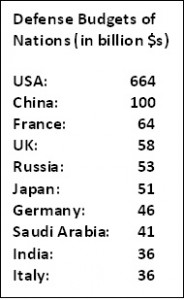 It is not easy for the government to extricate itself from the grip of the military and high-tech weapon industries. With their own self-fulfilling logic and clout in Congress, they keep coming up with new rationale, and newer, ever more sophisticated, and always costlier weapons systems.
It is not easy for the government to extricate itself from the grip of the military and high-tech weapon industries. With their own self-fulfilling logic and clout in Congress, they keep coming up with new rationale, and newer, ever more sophisticated, and always costlier weapons systems.
In 2001, the Congressional Budget Office hadestimated that for the year 2010-11, the federal budget would have $850 billion surplus. So, from an $850 billion projected surplus, we have nosedived to a 1,170 billion real deficit, a drop of over $2,000 billion. The main causes for this, as shown by the New York Times, are the economic downturn during George W. Bush’s first term ($ 290 billion), his Iraq War, tax cuts, and Medicare Part D prescription drugs ($670 billion), and  $470 billion during 2008-09 recession, totaling over $1,300 billion. Obama’s relatively smaller banking bailout only compounded the nation’s woes.
The situation in many state and local governments are gloomy as well. Over 44 of our 50 states (including California, New York, New Jersey, Illinois, and Pennsylvania) have budget deficits totaling $350 billion. Local governments throughout the nation, including the City of Pittsburgh, too have fiscal problems. The reasons are reduced tax receipts on account of the bad economy, unfunded commitments for padded pensions and liberal healthcare benefits for retirees, among others.
However you slice it, the prognosis for the combined fiscal woes of federal, state and local levels is not good. The eternal optimism traditionally espoused by many in the US — that technological booms based on our innovative instincts are just round the corner to bail us out — may be misplaced today. The world has changed. We have lost our edge in manufacturing, and become a service-based consumer economy. You cannot be the Sole Superpower with a weakened manufacturing base. Service jobs don’t pay well, and often don’t give benefits. Forget pensions. Meanwhile other nations are investing on education, innovation, manufacturing, thus shrinking our lead-time over others in our technological edge.
In earlier times, we benefited by the economic activity triggered by wars, as in WW I and II and the Cold War. We do not have that option now. We are already in two costly wars – in Iraq and Afghanistan — more or less by ourselves for nearly eight years, with nobody of substance to share the financial, military, and political burden. Only 1% of the nation’s population of 300-plus million is personally involved in the wars, with many men and women in uniform having multiple tours of duty. For the remaining 99% of the population, the impact of the wars is minuscule. There is no draft, and there is not even a financial obligation on citizens not in combat like an income-based War Tax. In fact, Bush-43 gave tax cuts in the midst of war. We cannot escape the consequences of all these financial excesses.
Rich nations lead by the US, through the World Bank and the International Monetary Fund, used to hector Third World countries in fiscal crises on austerity measures like devaluation, opening up for foreign direct investment, eliminating tariffs and subsidies (even as the rich nations were protecting their own industries). Now it is time we take the medicine we were prescribing for everybody else. It is already happening in Europe (Greece, Ireland, Iceland, Portugal and Spain).
That is precisely what the Simpson-Bowles Fiscal Commission appointed by President Obama recommends in their report (www.fiscal commission.gov/news See the item Moment of Truth): Trim all expenditures and subsidies, without any exception, including military, social security and Medicare. Its suggests simplified tax codes, a modest 15 cents/gallon gas tax, and removing tax loopholes. Everybody shares the burden. The rich will have to share more, as it should be. After all, they benefited the most from the fiscal irresponsibility of the last 30 years.
That both Democratic and Rightwing commentators denounced the report tells us that it is truly fair and balanced. Surprisingly, 11 of the 18 members of the commission endorsed the report. So, let’s get ready for some serious, inescapable belt tightening. This time around, it seems likely, we may have the courage and wisdom to do the right things. As the most powerful nation in the world with over forty Nobel prizes in economics, if we do not tighten our belt on our own choice, outside forces will impose it on us. Then we will be no different from the wretched Third World. ♦
Elections for the Office of the Governor
Posted by admin in October 2010 on October 17, 2010
By Dan Onorato
Editor: Mr. Dan Onorato, the Chief Executive of Allegheny County, is the Democratic Candidate for the office of the Governor of Pennsylvania in the November elections.
I am a second-generation Italian-American and as a child, my grandparents told me stories about their lives in Italy and instilled the importance of tradition and heritage. I understand that you, as a member of the vibrant Indian-American community experience these same feelings and emotions. I want you to know that I will fight for an inclusive and prosperous Pennsylvania, just as I have done in Allegheny County – a state with greater economic opportunity for all of our residents.
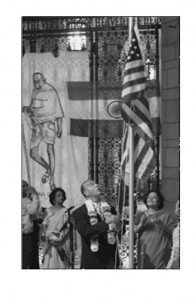
County Executive Dan Onorato hoisting the Stars and Stripes in an Indian-American function in Pittsburgh.
When I became AlleghenyCounty Executive in 2004, our region was losing population and employers and the county faced a substantial budget deficit. Today, after six years of my leadership, our county’s unemployment rate is lower than both the state’s and the nation’s and there are more people working in Allegheny County than anywhere else in Pennsylvania.
The next Governor of Pennsylvania will face a serious budget crisis and have to immediately restore fiscal responsibility to state government. I am the only candidate who has a record of turning around the economy, balancing a budget and running a government. I worked to turn around Allegheny County’s economy by making companies want to invest in the region. We need that same approach for all of Pennsylvania, and if I am elected Governor, jumpstarting our economy will be my highest priority.
Our state’s diverse economy has the potential for unbridled growth, but first we need to improve Pennsylvania’s business climate. As Governor, I will work to institute three key changes: 1) make business taxes more competitive; 2) make the permitting process business-friendly so that companies are assured of timely and consistent decisions when they want to invest in our state; and 3) ensure that our schools and workforce development programs successfully prepare the next generation of high-skill workers.
We need to ensure that our education system prepares our children for good jobs in the future. Last year, my oldest daughter left for college and like most parents, I want her to have the opportunity to not only live in Pennsylvania but to work in a thriving economy.
To do that, we need to start making the changes Pennsylvania needs by embracing our colleges and universities as springboards for 21st century professions and to expand Pennsylvania’s economy, and making college affordable for hard-working families.
We need to revitalize Pennsylvania and that is what I will do as our next Governor. I invite you to visit www.voteonorato.com to learn more about my plans to improve our Commonwealth.
I hope to see you at the polls on November 2. I need your support.
Delta’s Nonstop Flight to Paris Eases Travel to India
Posted by admin in October 2010 on October 17, 2010
Over 200 people were at the Hilton downtown for the reception organized by Ken Zapinski, senior vice president of the Allegheny Conference of Community Development and his staff in cooperation with the Pittsburgh International Airport and Delta Airlines. Bradley Penrod, the CEO of the Pittsburgh airport and Wayne Aaron, Delta’s vice president for corporate strategy addressed the gathering.
The organizers wanted to reach the Indian-Americans in the area for making better use of Delta’s nonstop flight to Paris. This is the first time such an interaction was taking place here between an air carrier and Indian-Americans. With this nonstop flight, travelers can reach Bangalore, Mumbai and Delhi with just one 3-h stopover in Paris by taking Air-France’s connecting flights from Paris to Indian destinations. This saves at least four hours travel time, not to speak of missed connections at JFK, Newark, or Detroit. This flight is convenient to business travelers, tourists, young parents traveling with toddlers/kids, and seniors traveling between Pittsburgh and India.
Towards the end of June officials of Delta Airlines, Pittsburgh International Airport, and the Allegheny Conference of Community Development met with Indian-Americans to promote Delta’s nonstop flight to Paris, which greatly simplifies travel to Indian destinations. This flight is Pittsburgh’s only nonstop trans-Atlantic flight to Europe.
Bradley Penrod and Wayne Aaron asked their audience to spread the word around of this Pittsburgh-Paris nonstop flight. Aaron asked his audience to give him both bouquets and brickbats on Delta flights. His audience did not disappoint him. Some of the complaints he heard are:
1. Not getting the boarding passes for the Paris-India leg of the journey when checking-in at Pittsburgh. This causes frustrating — and entirely avoidable –problems at Paris as people have to stand in line again at the Air France counter for the boarding pass to India. Is not Air France a member of Sky Team?
2. Not having nonstop Air France or other carriers’ flights from Paris to Chennai and Hyderabad, the cities that have good traffic to and from North America. For travelers from Pittsburgh, not having nonstops from Paris to Chennai and Hyderabad nullifies the advantages of the Pittsburgh-Paris nonstop flight.
3. The hassle of Delta’s older narrow-body Boeing 757 for the long Pittsburgh-Paris trans-Atlantic flight, and the need for improved cabin service, particularly in Air France flights to and from Paris and India.
Another suggestion was to reach out to passengers from this region bound for destinations in North Africa, Middle East, and Southeast Asia, who too can reach their destinations with just one stopover at Paris. This can also increase the load factor and revenue for the Pittsburgh-Paris flight.
With the interactions Aaron had with his listeners, chances are better now than before that Delta may fix some of these problems.
Delta’s Aaron briefly gave the highlights of the gut-wrenching changes in the airline industry. We all know. Airlines these days charge for checked-in bags, pillows, and blankets, and don’t serve even water in shorter flights to cut costs. The decline in the quality of cabin service in domestic flights is obvious for seasoned travelers.
But don’t expect a miracle any time soon. Why? Because air carriers live and die by a) load factors (the % of the seats occupied by paying passengers); and b) the revenue stream for each flight, which depends on the number of business travelers and the class of tickets airlines sell in the coach class.
Aaron told his audience that while the average load factors for Delta’s trans-Atlantic flights hover around 80%, for the Pittsburgh-Paris nonstop flight, it is low, only around 67%. If the passenger traffic and revenue stream for the flight improves, Delta is bound to deploy newer larger planes and give better cabin service.
In today’s globalized economy, easy access for travelers to Europe through nonstop flights is important for promoting Pittsburgh. We need to support these efforts by using the nonstop flight to Paris.
Along the way, if it also makes our life easier, we should give it serious consideration.
Our elected officials, Pittsburgh airport officials and business leaders are trying hard promoting Pittsburgh as a business friendly city with all modern amenities for starting and running businesses and for living and raising families — amenities such as excellent public and private schools, universities for higher education, medical facilities, recreation and entertainment resources, museums and arts that we have in abundance.
In today’s globalized economy, easy access for travelers to Europe through nonstop flights is important for promoting Pittsburgh. We need to support these efforts by using the nonstop flight to Paris.
Â
Volunteer Work in Haiti After the Big Quake
Posted by admin in October 2010 on October 17, 2010
By Vasu Malepati, MD, McMurray, PA
Editor’s Note: Vasu Malepati, an ear-nose-and-throat surgeon working from the Mon Valley Hospital, is a long-time resident of the Pittsburgh Metro area. After his medical degree from the Venkateswara Medical College in Tirupati, Andhra Pradesh, he reached the US over three decades ago. Malepati is medical missionary of sorts: He worked in the 2001 Indian earthquake relief efforts; spent three weeks in Sri Lanka after the tsunami in 2005 that swallowed nearly 200,000 people; and volunteered in Indonesia during the tsunami. He has treated needy patients in Honduras, Guatemala, British Guyana, and Vietnam. He participated in two separate medical missions to the Philippines, and conducted free clinics there performing surgery with his colleague Dr. Chito M. Crudo, a gastrointestinal and general surgeon at the Mon Valley Hospital.
In late January this year, an earthquake that geologists have been warning Haitian leaders for years, pretty much leveled Port-au-Prince, killing over 200,000 people, destroying the entire city and the island nation. The damages of the severe quake (measured at 7.0 on the Richter scale) were made worse by the criminally negligent building practices in Haiti, traceable to endemic corruption at every level in the country.
It was heart-wrenching to see men, women, and children waiting for hours to be seen by a doctor at the clinic. In the midst of the utter devastation, they were patient
In the weeks after the quake, with twelve men and women from across the US, I was in Haiti working towards alleviating the pain and suffering of the people of Port-au-Prince, the capital, to the extent we could. The twelve of us were from the Satyasai Medical Association International (SAI), which established a Haiti Earthquake Relief Fund. We—five doctors, two nurses, and five nonmedical volunteers—spent five days treating over 1,500 patients in St. Angeles Church in a makeshift clinic.
It was heart-wrenching to see men, women, and children waiting for hours to be seen by a doctor at the clinic. In the midst of the utter devastation, they were patient and grateful for the help they were receiving, both medical and emotional. We treated medical emergencies as well as non life-threatening conditions such as hypertension and anxiety.
We stabilized patients needing further medical/surgical care and sent them to the International Medical Corps in downtown Port-au-Prince. We gave medications to sick families, and a volunteer from the SAI group cooked and served meals for the public. With my wife Dr. Durga Malepati, we provided free medical checkups and distributed clothing to children.
We at SAI group, joining the American Red Cross and St. Angeles Church, made arrangements for lodging, food, local transportation, and a translator from the local French dialect to English.
I have been to many places of natural disasters, but what I saw in Haiti was the worst and will never leave me. People were wandering the street looking for water and food. The damage was utterly devastating. I felt it was my responsibility to help people in any way I could.
Because of the dire need for medical attention and the gratitude of the Haitian people I saw, my experience in Haiti is one of the most satisfying mission trips for me.
There still is much to be done. They need medical care, emotional and financial support, and all kinds of assistance. They need our time. They need your time. The needs of the Haitian people are many, from medical care and housing to learning English and nutritional meals.
To find out how you can help, visit www.redcross.org or www.UNICEF.org, contact local church groups, or donate online. Medical professionals can also volunteer through International Medical Corps or a local volunteer organization near you.
I plan to return to Haiti to provide additional medical care and to follow up on the people I treated.
Many people have asked me about the motivation for me to go to places where Nature unleashes its fury. I can only recall the words of my Guru Sai Baba: “Helping hands are holier than praying lips.” I am also inspired by Mother Theresa’s Simple Path: “The fruit of silence is prayer. The fruit of prayer is faith. The fruit of faith is love. The fruit of love is service. The fruit of service is peace.”
Triveni Int’l Club’s Colorful Arts Event
Posted by admin in October 2010 on October 17, 2010
e-mail: samar_k_saha@yahoo.com
The Indian Diaspora, I always believed, have a lot of hidden talents other than what they do professionally for living. They must have inherited some of the artistic genes of their ancestors who have amazed the world in past and present. This got a boost in the art exhibition organized by Triveni International Club at the India Gardens in Monroeville on August 28, 2010. Chairperson, Dolly Luthra, summed up the event nicely: “Pittsburghers have artistic talents. Some are well-known locally and elsewhere. Many are in other professions and pursue their artistic interest in anonymity in spare time. The idea behind organizing the event is to have the artists share their talent with the community at large.”
T he displays and the artists were all there – a dozen or so participants.Â
Manenda Bhende, a physician specializing with the victims of child abuse, put her mark on ‘darkness-to light’ theme on at least two of her paintings. Brightly colored balloons floating over a dark river of cruelty makes you think how hope and despair can live side by side. Sarika Goulatia, a CMU arts graduate, presented her work inspired by the political events in an abstract style — open to viewer’s interpretations. Terrorist attack in Mumbai and the resulting devastation was well put in dashing brush strokes in acrylic.Â
Rashmi Bhalakia presented her art of Rangoli. It made you wonder how Rangoli, an ancient cultural tradition and folk art dating back to the time of Mohen-Jo-Daro, has survived so beautifully.
Sunil Parulkar, a urologist, told us how he likes to create simple pleasures of life that people can relate to. His drawings were truly of professional quality which brought chuckles to every face. As satirical as these cartoons were, there were also touches of hilarity in many of them.
Chitra Teredesai’s work was visually wonderful. She has exhibited her creations before in the US. For this exhibition she presented some of her study of Rajasthani faces depicted in water color. Each face carried powerful emotions that simply drew you to the subjects like a moth to a flame.
Asmita Ranganathan, another healthcare professional and a part time illustrator for a children magazine “Bala Gokulam” presented her pencil sketches and water colors. Mahendra Shah, an architect, loves jokes and his professional level cartoons tell you that. It was fascinating to see how meticulous and patient he is in two of his framed works detailing the traditional intricacies of the Mithila School of Arts style.
Pratibha Khurana displayed an acrylic version of Napoleon Crossing the Alps, which showed the gusto reserved only for the heroes of the lore. Her other works were there in oils.
Rani Kumar, an ER physician, presented a few pieces of her charcoal and pencil work and explained how she soothes her raw nerves from the day’s work related tensions and drudgeries by burying herself in arts.
Kiran Parikh and Rupa Rokadia demonstrated and explained the art of working with polymer clay, shaping into various forms of art objects. Kamalesh Aggarwal displayed his paintings and photographed the work of others through the eyes of a camera.
Neera and Neeraj Tayal’s painstaking needle work and framed photos were simply beautiful. Some photo were so good, they looked straight out of National Geographic.
Yasmeen Ariff-Syed’s artistic talent was on display in her creations with clays with many of her glazed pottery work exhibited.
One of the well established artists of the region, Harish Saluja was also there. He invited all to his exhibition Mandalas & Deities – Recent Paintings at the Mendlson Gallery from September 3 to October 2, 2010.
Juginder Luthra of Weirton, one of the organizers, thanked the Steubenville Art Association for lending the display panels and Weirton Area Museum and Cultural Center for the easels and the projector.
It was very heartening to see so many artists living among us getting encouragement from their friends and peers. The glow on their faces told the story of all the hard work that went behind the scene.
Note: Amar Khurana of Moon Township took the pictures used in this article. He has been a Pittsburgher for nearly three decades practicing internal medicine. Amar Khurana also created the collage of pictures you see on the cover page.
Â
Â
Indian Cable TV
Posted by admin in October 2010 on October 17, 2010
By Kollengode S Venkataraman
Cable TV has pervaded India. In every medium-size town and its surroundings, you get Bangla, Gujarati, Marathi, Tamil, Malayalam, Telugu, Kannada, Hindi, and Punjabi channels; and Indian English channels, BBC, Nat.Geo, and the Indian versions of CNN and CNBC. This had transformed India in many, many ways. Here are some:
India’s many cable TV channels hold music competition in all Indian
languages for those under 25. Invariably, these youngsters choose semiclassical or fully classical film songs, a genre in which India has an extensive repertoire of lyrics in all languages. The songs are in the language of the TV station conducting the program. Asia Net, the TV station in the Malayalam language of Kerala, is an exception. In Asia Net, competitors can sing Tamil, Telugu, Kannada, Malayalam, and Hindi songs. The judges are veteran music directors or playback singers, who are very fussy when they assess the singers after they display their best skills.
Cable TV has given these youngsters opportunities to display their talents, something they never had before in the monopoly days of government-run TV. In Jaya TV’s Ragamalika program, veteran musicians in front rows are seen enjoying as they watch the youngsters’ musical talents.
These youngsters don’t seem to come from homes with a long tradition in classical music. They don’t have the pedigree we see in the hyped-up brochures of Indian classical musicians visiting the US. Which makes me wonder how much farther these youngsters would have gone — and how much wider the ticket-buying audience base for classical music would have been — if only these youngsters had the opportunity to learn Indian classical music formally. These youngsters are India’s Ekalavyas today.
An assortment of religious channels – Hindu, Christian, Islamic,
and Sikh, widely varying in the quality in what they peddle and how they peddle it – also crowd the airwave. It is funny to watch American Christian televangelists’ fire-and-brimstone sermons dubbed in Indian languages. Having watched them on TV here – I watch them more for entertainment than enlightenment — they appear to speak in tongues!
The false piety and religiosity on garish display on many religious channels have made even my 84-year old religious – not religiose – mother skeptical of these Merchants of Gods. Only a few of them are good. Isha Yoga Center, for example, persuades people not to get embroiled in excessive religiosity, emphasizing lifestyles based on work, faith, simplicity, charity and contentment.
Tamil, Telugu and Kannada masala films on Cable tell another story. In these, actors with make-up to look dark, rustic, rural, less educated and oily-looking, continue to chase svelte and light-skinned — “wheatish” in the Indian lingo — socially upper class kunwaris (girls) in song sequences. They feed the fantasy of filmgoers by making the “wheatish” belles madly in love with the dark, rustic heroes from a socioeconomic class several notches lower in the Indian social pecking order.While in Coimbatore last year, I read a graphic Tamil film title Karutta Paiyyan Sevatta Ponnu — meaning literally, A Dark-Skinned Boy and A Light-Skinned Girl. Several years back, the Kannada filmdom gave this gem of a title for a film: Bili Hendati — literally, White Wife.
These days, light-skinned South Indian belles are not good enough to whet the fantasy of South Indian filmgoers. So they import “wheatish” Punjabi kudiyans to the mix of heroines taking full advantage of the technology in dubbing. (Bollywood now has European, Central Asian, and South American belles.)
In these films, the hero is portrayed not interested in taking advantage of the heroine’s advances, at least initially. But soon, all hell breaks loose and they chase after each other in exotic locales lip-synching songs with convulsive dance moves that put MTV to shame. In this MTV adaptation of film songs — invariably group songs with the hero and heroine amidst a bevy of starlets in contrasting costumes — the dresses for the women have become tighter and skimpier. Further, the extremely physical and tight dance moves between the dark heroes and the “wheatish” heroines and the graphic lyrics in pulsating beats leave nothing for imagination.
In disgust you flip through the channels when you sometime see old “love songs” from Hindi, Malayalam, or Tamil films with emphasis on lyrics and melody, with no convulsive dance moves. Aaahh! What a great sense of heavenly contrast they provide! For me, in portraying amorous situations, what is left unsaid and undisplayed is more sensuous than the epileptic moves and the graphic lyrics in today’s Indian film songs.
Actors in Indian TV commercials (and models in bill boards across
the country) for consumer goods are so light-skinned that they are not like anything you see in people even in most Indian upper crust homes. Their chemically bleached skin and the bad dubbing of the commercials into other languages from their Hindi original make them look like pale Azarbaijanis and Kazakhstanis in Indian costumes.
I wonder if Indian sociologists or psychologists have studied how Indian kids subliminally internalize what they see in commercials and compare their darker — but gorgeously lovely — hues of skin tones against the bleached light-skinned models in commercials. These children, women in particular, may even develop image problems in their adulthood. But then, in matrimonial descriptions, parents continue to seek for their “wheatish, convent-educated, degreed” daughters “well-educated, well-placed professional grooms” from “respectable middle class families.” The grooms’ parents are also equally honest.
This, in a country in which dark was considered beautiful, if you go
by its old literature. In Sanskrit, shyama means black or dark. Shyamalaa, Shyamasundari are descriptive names for women used even today which literally mean, “She Who is Dark,” and “A Dark Beautiful Woman.” Shyama Shastri (literally, Dark Scholar), one of the great Karnatic composers, has chose Shyama-Krishna Sodari (Sister of the dark-Krishna, a descriptive name for Parvati) as his mudra (signature) in all his compositions. One descriptive epithet for Krishna/Rama is Neela-Megha-Shyamala, literally, “He Who is as Dark as the Dark Blue Cloud.” Krishna itself means black, as in krishna-paksha (the 14 days after full moon).With India becoming prosperous, and if the prosperity percolates across the whole population, there is a slight chance that Indians maybe, just maybe, comfortable with their luscious natural skin tones in the whole range of their hues. That is at least one or two generations away.
For now, Indians have to not only live with film titles like Karutta Paiyyan Sevatta Ponnu (A Dark-Skinned Boy and A Light-Skinned Girl), but also be mentally prepared for more ghastly titles like Kannamkarutta Paiyyan Sekkasevatta Ponnu (A Jet-Black Boy and a Lily-White Girl).
Personally Speaking … … A recent e-mail took me back to my college days
Posted by admin in October 2010 on October 17, 2010
Editor’s Note: This is a new feature we begin. We invite you to share your personal experiences in your childhood, youth and adult life, as a new immigrant in the US, during travel, or at work. It does not have to be serious. Humor and irony are just as fine — even better. The word count is 600 words max. This write up is 480-words long.
Recently, I received a forwarded e-mail from India whose intent was to make the reader laugh (condescendingly, of course) at the misspelled English words and out-of-syntax construction of sentences by Indians. The e-mail had direct quotes from Shadi.com in which Indian men and women —evidently not well-schooled in the English language — list their expectations from their life-partners. A verbatim example:“Hello i am a good charactarised woman. i want to run my life happily. i divorced my first husband. his charactor is not good. i expect the good minded and clean habits boy who may be in the same caste or other caste accepted.â€
Most of the young men and women writing in shaadi.com — I pity these poor creatures — might not have had rigorous training in English grammar or on the orthographic nuances of the English language. So, only with difficulty I could see the humor in these awkward constructions.
Then I wondered how many “modern†Indians can write their expectations of their future spouses in their own mother tongue, or in any Indian language they were schooled in — even with grammar and spelling mistakes?
Sixty years after India becoming a republic, Thomas Babington Macaulay finally succeeded in producing brown sahebs en masse. These “Children of Macaulay,†as my friend Deepak Kotwal of Squirrel Hill calls them derisively, can now mock at their fellow citizens who’re not lucky enough to be born into resourceful families to afford quality English schooling. Will it ever occur to “modern†India that English is not her native language?
This brings back memories from my own journey. I am going back over forty years to my pre-University days at Agurchand Manmull Jain College in Minambakkam near the airport in Madras. In physics and mathematics classes, I had questions needing clarifications. I was from what the Indian upper crust derisively calls the “vernacular†medium, with Tamil as the language of instruction up to high school. Obviously, my English was wanting in every department — vocabulary, grammar, syntax, diction, and pronunciation. (It is better now, even though it could be improved.)
In the class, mentally I would struggle to frame the questions in English and rehearse them sotto voce before airing them, lest I become an object of ridicule in the class. By the time I gathered the courage to raise my hand and ask the question, my teacher would have gone ahead four or five steps in the derivations. I would become even more afraid to ask the question — now not only my English would be seen as bad, but I would also come across as a dimwit for asking the question so late.
So, I never would ask any question even though my looks betrayed my struggles. Seeing my struggle, my physics lecturer, Mr. Srinivasan, one day told me and everybody else in the class, “Paravaillappa. Tamizhileye chollu.†(“It’s OK kid. Say it in Tamilâ€). My eyes swelled in tears, partly out of embarrassment and partly out of gratitude for Mr. Srinivasan.
This is still fresh in my memory, even after four decades.
My conversation with the Almighty
Posted by admin in October 2010 on October 17, 2010
Kannadasan is one of the great poets, lyricists, and social commentators of mid 20th century Tamil society. He did not have formal education beyond 6th or 7th grade. His poems and prose are simple and direct conveying complex ideas, thoughts and feelings with fewest words that alliterate and rhyme as well. He was a colossus in the 20th century Tamil cinema.
Kannadasan was a self-taught genius with lots of personal faults and weaknesses. Many students have earned their PhDs studying his literary work.
I am happy to present one of Kannadasan’s poems that I am sure will resonate well with readers — even in its non-poetic translation. — KSV
 “What is birth?†I asked.
“What is birth?†I asked.
“Be born and see!†He said.
“What is learning?†I asked.
“Learn and see!†He ordered.
“What is wisdom?†I asked.
“Be wise and see!†He ordered.
“What is love?†I asked.
“Give it and see!†He said.
“What is affection?†I asked.
“Share it and see!†He told.
“What is conjugal bliss?†I asked.
“Marry and see!†He said.
“What is a son?†I asked.
“Have one and see!†He said.
“What is old age?†I asked.
“Get senile and see!†He told.
“What is poverty?†I asked.
“Be deprived and see!†He said.
“What is after death?†I asked.
“Die and see!†He said.
“If experience alone is the path in life,
God, why do I need you?†I asked.
Leaning closer, He whispered,
“Verily, I myself am that very experience.â€
So the Pretty Woman is Now a Practicing Hindu
Posted by admin in October 2010 on October 17, 2010
By Arun Jatkar, Monroeville PA
Arun Jatkar, a long-time resident of Monroeville, is also the editor of Ekata, the North-American Marathi monthly, and a past president of Toastmasters International. n
So the Pretty Woman is now a practicing Hindu! For those who are pop-culture challenged, the woman is Julia Roberts. That brings several possibilities for joint Hollywood-Bollywood chick flicks par excellence:
1. The saffron brigade starts giving out free tickets to the movie Julia Roberts made in India last year.
2. The Shaktas in India start figuring out the best way to indoctrinate Julia as the High Priestess of Pataudi.
3. There are commotions from the Kamakshi temple in Assam to Meenakshi temple in Tamil Nadu and from the Kali temple in Kolkata to Mahalakshmi temple in Mumbai for special pujas.
4. Sonia Gandhi, worried that she is likely to be upstaged in popularity by an American woman, discusses with the Vatican to obtain a special Papal dispensation for practicing dual religionship.
5. Shahrukh Khan does not wish to be upstaged in popularity by two Gora women. He is consulting the top ten astrologers in India to decide upon the most propitious date for conversion to Hindu religion. The Shah-i-Imam issues a fatwa and Khan goes incognito (agnaata-vaasam).
6. In Dubai, the nervous painter M. F. Hussain is consulting the professors from J. N. University in New Delhi on the likely fallout.
7. Professors from the J.N. University leave New Delhi for a month-long huddle session at Aligarh Muslim University to come out with the most positive secular spin on Julia Roberts’ conversion to Hinduism.
8. The Marxists in West Bengal and Kerala, the Naxalites in Srikakulam district of Andhra Pradesh, and Maoists in Jharkhand declare a week-long “India Bandh” protesting Julia’s conversion to Hinduism.
9. Since the word “Juli” means “twin” in Marathi, many Maharashtrians are wondering why no one is talking about Julia’s sister.
10. Bal Thakaray sends a few Shivasainiks to USA to tell Julia Roberts’ sister that if she becomes a Hindu, Shivasena will get her elected as the Mayor of Mumbai for life.
e-mail: ajmarathi@yahoo.com
Chinmaya Mission’s Ramayana discourse
Posted by admin in October 2010 on October 17, 2010
by Kris Gopal, Upper St. Clair, PAÂ
Chinmaya Sanjeevani of Pittsburgh hosted a 5-day discourse on Sundarkand of Tulasi Ramayan by Swami Tejomayananda, the head of the Chinmaya Mission worldwide. The event was organized at the Monroeville Convention Center. Sri Goswami Tulsidas, in Sundarkand sings praise and glories of Hanuman and Sri Rama.
With his good grasp of the Sundarakand, both the original in Valmiki’s original and Tuladidas’ re-rendering of it, the Swami treated the devotees to a delightful discourse. His passionate rendering of the verses and his interpretation made simple and relevant to contemporary life, were quite impressive. Sprinkling humor, he delighted the audience with his inimitable story-telling skills.  Hidden in these verses, he told his audience, are the guidelines for living a life with contentment and in peace.
On Tulasidas Ramayana: Saint Tulasidas (time: 16th century) known as Rambola, became a devotee of Rama at the nudging of his wife, and wrote the Rama-carita-maanasa in Avadhi, a Hindi dialect, popular in Eastern Uttar Pradesh at that time. Tulasi Ramayanam is popular in northern India.
On the opening evening, the students of Chinmaya Sanjeevani Bala Vihar recited the Guru Stotram. Tiny tots and young children recited from memory the Sanskrit verses with perfect diction in front of a large audience. The Bala Vihar teacher Shuba Sriram arranged this group singing. The kid’s age ranged from 3 to 13 years.
An exhibition in the hall highlighted the mission’s activities, sold books. Balavihar activities for children and youth is one of the big part of the activities of the Chinmaya mission. The Sunday classes teach young enthusiastic children the basic tenets of the Hindu faith and culture, Sanskrit slokas and the essence of the Bhagavad Gita. One parent summed up their experience in bringing their children to the balavihar classes: “We too benefited in our spiritual growth in these classes.”
During the five days many other activities were also held both at the Convention center and at the Chinmaya Mission’s Sanjeevani center at Monroeville. One was the rendering of Hanuman Chalisa, forty 2-line verses in praise of Hanuman in Avadhi also the work of Tulasidas Goswami. Chalis in Hindi means literally “forty.” Reciting these verses, the Swamiji said, helps people to purify their thoughts and speech, which reduces mental clutters and calms mind. This reduces anxiety and fear, which aids in recovering from debilitating sicknesses.
Hanuman Chalisa is sung in India with great love and devotion. Some sing it as a daily prayer. The Swamiji sang it to the delight of the devotees in different ragas and explained its meanings.
At the Chinmaya Sanjeeveni facility at Monroeville, the Balavihar children welcomed Tejomayananda.
The Mahotsav was successfully organized under the leadership of local mission President Mrs. Smita Gosai aided by host of volunteers and Bala Vihar teachers assisting her with long hours of work. They also worked to feeding all the attendees with delicious meals all the days.Â
Â
Â
Â
Â
Â
Â
Â
Â
Dekho Yahan Hindustan our Pakistan
Posted by admin in October 2009, October 2010 on October 17, 2010
 This is not some synchronized sports event or a scene in street theater in one of New York’s ethnic festivals. This is during the official flag lowering ceremony at the Indian-Pakistan border at Wagha between the states of Indian and Pakistani Punjabs — yes, India and Pakistan have states with identical names. The white line at the bottom is the official border. Soldiers in black are Pakistani soldiers and those in khaki are Indian jawans.
This is not some synchronized sports event or a scene in street theater in one of New York’s ethnic festivals. This is during the official flag lowering ceremony at the Indian-Pakistan border at Wagha between the states of Indian and Pakistani Punjabs — yes, India and Pakistan have states with identical names. The white line at the bottom is the official border. Soldiers in black are Pakistani soldiers and those in khaki are Indian jawans.
This 50-plus year old well choreographed simulated spectacle in jingoism by Pakistani and Indian soldiers is a daily tourist attraction. One wonders how the two countries that do not agree diplomatically on anything, mutually evolved this absurd synchronized jugalbandi tamasha.
There is a new twist to this daily ritual. In July 2010, India unilaterally decided to lower the theatrical aggression in what The Hindustan Times calls “good-natured rivalry.” Soon, Pakistan reciprocated, lowering its simulated belligerence. But don’t expect any thaw between the two countries whose views of their own common history is at such wide variance.
The reason for the reduced belligerence in the ridiculous enactment is more orthopedic than diplomatic. The soldiers participating in the daily rituals ended up with mild-to-severe knee injuries. If you Google search “Change of guard at Wagha border,” you will get several video clips and see for yourself the absurdity of this aggressive seema-tamasha.– KSV
Good News! Indians are not A “Minorityâ€
Posted by admin in Past issues, Venkat's and Others' Selected Earlier Articles on July 15, 2010
By Kollengode S Venkataraman (Published in July 2010)
Recently Carnegie Mellon University published in their in-house publication Focus (Vol. 21, No 8, Spring 2010) some statistics around the demographics of their student body and staff. Race and gender being dominant parts of social discourses in the US, the stats were broke down along race and gender:

Notes: Blacks and Hispanics in the US form 23% of the population. At CMU 15% of undergraduates and 48% of graduate students are international.
Interestingly, CMU has grouped Asians (including Indians) along with majority Whites in the racial mix of the university body:
Tenure-track faculty: 91% White and Asian American
Other staff: 87% White and Asian American
When contacted, Ms. Janel Supkus, Head of Institutional Research at CMU, told The Patrika that in the context of the demographic makeup of the nation’s population, people of Asian and Indian heritage are not under-represented in the CMU community; but women, Blacks, Hispanics and Native Americans are. That is why the university has not been classifying Asians — Chinese, Koreans, Japanese and Indians — as minorities. If any, most of these can be realistically called privileged minorities.
Well, simply walking along the campus, we can even speculate that these Asians are over-represented in the university’s demographics. This grouping of Asian- and Indian-Americans along with Whites is a trend what we will see more and more in other walks of life in the future.
In the American context, Indian-Americans may be a minority in numbers, but bulk of us come from what can be only called a “privileged†minority: Because of skewed immigration, a large proportion of us have better education and/or entrepreneurial skills, hence higher earnings and net worth than the national average. We give our children stable homes — so critical for their growth socially and psychologically in their formative and later years — even though most of our marriages may not be the happiest ones. We endure in our marriages for the sake of our children.
As Indian-Americans, coming out of the minority classification ought to be liberating at one level. It’s an affirmation of how far we have come since the Asian Exclusion Act of 1924. Going forward, the concept of Affirmative Action and Equal Opportunity Employment are going to be irrelevant for most of our children.
But this puts the children of gas station attendants, taxi drivers, restaurant cooks and others of Indian origin at a great disadvantage. To address this inequity, educational institutions need to look at the 1040 forms of the parents of Asian students before deciding on financial awards. This is one way to give a break to college applicants coming from socioeconomically disadvantaged homes – whether white, black, brown, and yellow.
Going forward, we are going to be judged, to quote Dr. King, “not by the color of our skin [or other features], but by the contents of our character,†to which we may also add, our intellect, skills, and how we respond to our social obligations here in the US going beyond paying taxes. This is enough motivation for us to give back to society what we have received from Providence and from this land of opportunities. –– END
Bridle the “Free†Market
Posted by admin in Past issues, Venkat's and Others' Selected Earlier Articles on July 15, 2010
By Kollengode S Venkataraman (Published in July 2010)
There is an axiomatic belief bordering on dogma among conservative Republicans and Libertarians that less governing is better governing, and that a Free Market system is self-correcting.
But Free Market has never been free. After all, elected officials pass laws creating the environment in which the supposedly Free Market can operate. In making laws, elected officials jostle to pick the winners, or at least load the dice to favor the interest groups favorable to them. That is how hundreds of thousands of lobbyists for every imaginable interest group make their living in cities, state capitals and in Washington, DC trying to load the legislative dice in their clients’ favor.
Besides, when the supposedly free-market-driven system in banking, finance, manufacturing, and the energy sectors takes the country to the brink of collapse – and this happens predictably in the US every 15 to 20 years – tax payers have repeatedly coughed up big-time monies to bail out businesses because they are “too big to fail.†The bailout monies have only become bigger with every new scandal.
Let’s us face it. Private enterprises are value-neutral, driven only by their profit motive. What they do to society at large is not their concern as long as they make profits, and they make more profits than their competitors. Along the way, they often have done irreparable damage to land, water, and people’s lives. Just see the abandoned ruins of industrial sites — mining in the West, or in the industrial heartland in the US – where the owners simply walked away after exploiting the land and the resources for decades without remedying the land they exploited for profit. And now in the Gulf of Mexico BP has become a four-letter word. Similarly, the history of occupational diseases and industrial hygiene tells how workers’ health was ruined by the working conditions through the ages. This, we all have come to recognize, is the price for progress.
In explaining the recent shenanigans of the banking and insurance industry that took us to the brink of financial collapse, commentators used casino metaphors. Remember, taxpayer monies in trillions — 1 trillion is 1,000,000,000,000 — were used to bail out these guys for their recklessness. In casinos too, as long as the house gets its money, its operators don’t care what happens to gamblers. But gamblers at least know the odds are heavily against them. In this financial shell game, investors were not told of the heavy odds against the different financial instruments the banks created and sold, even though the banks knew this game would collapse sooner or later. They even betted against these instruments themselves, making huge profits even as their clients lost.
Goldman Sach’s CEO Lloyd Blankfein was like a poker player when he testified with a straight face on April 27, 2010 before Congress that he didn’t pay attention to the credit ratings Wall Street uses all the time to peddle financial products to investors. Not surprisingly, New York state’s attorney general Andrew Cuomo is investigating “investment banking companies whether they provided misleading information†to the rating agencies (Standard & Poor’s, Fitch Ratings and Moody’s) “to inflate the grades of mortgage securities.†Among the banks investigated are Goldman Sachs, Morgan Stanley, UBS, Citigroup, and Merrill Lynch. Attorneys general do not start expensive investigations unless they see a prima facie case.
When the lives of people are ruined, Wall Street’s high-stakes poker players escape saying, Caveat Emptor or Buyer Beware. Precisely because buyers – even the sophisticated ones — are not able to comprehend these complex and “synthetic†investment instruments, the strong arm of the State needs to intervene to protect individuals and the society at large.
Market-driven economy’s virtue is not that it is the best, but that all other economic systems are far worse. It is the same with elected governments. It is not that elected governments are the best, but all other systems of governance are far worse. Elected governments have checks and balances they have set for themselves to limit autocratic tendencies among rulers. Even then, there is no guarantee. Similarly, to protect ordinary citizens, it is necessary that governments regulate the supposedly free market system with laws with criminal consequences much the same way the criminal justice system takes care of crimes.
After all, after economic collapse, the big players, with their huge severance packages, move to their safe havens scattered all over the world, while the presidents, governors and mayors are left to salvage the physical ruins of the land and the economic ruins of people left behind.
Coincidentally, in April British Petroleum’s deep-sea oil well 40 miles south of New Orleans ruptured and the offshore platform Deepwater Horizon exploded killing eleven workers. Every day 2.25 million gallons of a mixture oil and gas has been spewing out of the rupture at 5000 feet below sea level polluting the American shores in the Gulf of Mexico. The mavens of American finance and manufacturing have been blaming everybody else but themselves to the catastrophes. Is there any wonder why nobody in the US trusts CEOs? — END
Breast-feeding is Priceless
Manjari Manoharan Kulkarni is a native Pittsburgher. She lives in Manhattan with her husband Rajiv, daughter Leela and dog Indiana. Manju enjoys practicing/teaching yoga, learning philosophy, eating healthy and reading. She is an orthodontist in New Jersey and enjoys making people smile!
When we discovered we were expecting, my husband and I were thrilled. To prep for the pregnancy and labor we read volumes and attended intense birthing classes. Nine months flew by and before we knew it – Baby!
However, no one told us about what happens after the baby comes. My obstetrician did allude to it when he asked if I wanted to breast feed. I simply shrugged “Yes,†and with no further information was shuffled on to the ultrasound. How I wish I was forewarned!
Breastfeeding turned out to be anything but simple. My vision of Yasoda seeing the Universe in her child’s mouth was swapped with thoughts of failure as my frustrated baby cried out in hunger. After multiple failed attempts, even our pediatrician suggested I skip directly to formula. After all, most Americans in the 1970s were raised on formula and we all turned out fine, right?
I naively believed that breast feeding would be instinctual. Evolution would prevail and baby and I would figure it out. But, years ago women learned from peers. All I witnessed was a covered woman with a baby underneath. What was going on under there?
Today’s reality is that expecting moms are bombarded with advertisements and free samples for formula. The tag lines on formula containers read “Breast milk is best, but for those that can’t, formula is almost as good.â€Â Formula was an instant solution to my problem.
Fortunately, my instinct told me not to give up. Searching for help, I found a lactation consultant. She visited my home to teach me proper positioning and encouraged me. I joined lactation clinics where I commiserated with other breast feeding challenged moms. And, I rented a hospital-grade breast pump to help boost my milk supply. In the initial weeks the physical pain and sheer exhaustion of breast feeding made child birth feel like baking cupcakes. But, after truly appreciating the benefits of breast milk, it was worth the effort. And it got easier.
Moms refer to breast milk as “liquid gold,†not just because of the effort it takes to make a few ounces, but also due to the following benefits, among others:
- A 2004 study in Lancet showed that breast fed children have 14% lower cholesterol as adults
- Another 2005 study in American Journal of Epidemiology tells finds that children who are breast fed for at least 9 months have 30% less risk of obesity.
- Breast milk contains antibodies that are passed from mother to child to help build immunity resulting in innumerable benefits
- In 2007 the American Institute for Cancer Research showed reduced risk of breast cancer in both pre and post menopausal women who breast fed for at least six months
So starting children off with breast milk gives all of us the best foundation for good health. Talk about true health care reform!
As a working mom, I invested in a portable breast pump and supplies. These items were costly, but relative to the health of my child, money well spent. In addition, employers benefit from accommodating breast pumping. Babies that are fed breast milk are healthier, resulting in a happier mom with fewer days off.
From an environmental standpoint, breast milk is locally grown (!) and has no waste when compared to the demands of producing and distributing formula. Breast feeding is an effective way for humans to reduce our carbon footprint, right from day zero.
Ultimately, the key to successful breastfeeding is a rock-solid belief in the benefits. Having a supportive husband helps too!
Remember these:
Breast pump: $$$$. More groceries for mom’s increased appetite: $$.
Lost Hours of Sleep: Too many to count. Benefits to Baby and Mom:Â Priceless
To learn more about breast feeding, benefits, and resources, visit the La Leche League website: LLLi.org.



